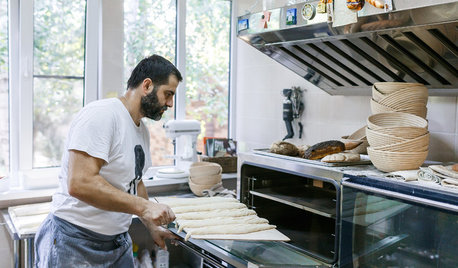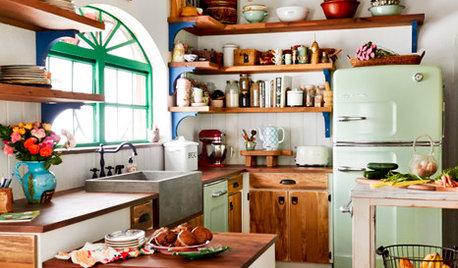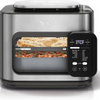RECIPE: Ricotta (Italian) Cheesecake
I'm a newbie here and thought you'd like to try a recipe I've been fooling around with for a while. The concept is not especially original but there are some added fillips and it's so detailed, that relatively new bakers should be able to have success with it. It's always been a crowd pleaser no matter what assortments of flavors or amounts are included, and folks can be as original as their imaginations allow. I'd favor comments or suggestions, even flames and trolls. They're always fun.
Ricotta (Italian) Cheesecake April 15, 2007
Serves 10-12
This light, delicate, citrus-y cake usually has a graham cracker crust which turns out to be mushy and adds little to flavor or interest. This recipe encorporates any simple sweet pastry crust (pate sucree), moisture-proofed with chocolate, which will add a contrasting texture and a slight background hint of the chocolate. It requires some prep work but is worth the pudding, as it's said.
The cake can be served as is, or with an accompaniment of berries. A raspberry coulee makes an interesting counterpoint.
The cake itself contains only ricotta cheese, eggs, heavy cream, a bit of flour for cake structure, and some flavorings. This is standard. As usual, it's the way these elements are combined and baked that makes for success.
The flavorings are variable, the amounts shown are approximates. Anything appealing and appropriate can be added, like crushed toasted almonds, hazelnuts, raisins and the like. Even graham crackers can be added to the pastry mix for the bottom crust.
This recipe is not especially unique, but the baking times/methods are somewhat different. Careful control of the oven temperature is essential to achieve the highest rise and fluffiest product. Too high a baking temperature will set the top and sides before the cake has achieved the highest rise.
Most recipes call for a 12" springform, which makes a large cake and is a bit difficult to handle. For this cake, the ingredient amounts have been reduced for a smaller springform pan and makes for easier serving.
One last thought: The directions here are detailed, experienced bakers can use their own recipes and methods for blind-baked pastry crusts and flavorings. Everything is shown for completeness.
EQUIPMENT and PREPARATION:
Springform pan, 8" diameter, 3" sides.
17"-wide heavy-duty aluminum foil to both blind-bake the crust, and cover the bottom and sides of the springform during cake baking.
Stationary counter-top mixer. Another hand electric mixer is useful but not necessary.
Ban Marie (use a 12" sautpan, or cake pan with 2" sides).
Large wire whisk or spatula for folding.
Pie weights or dried beans for blind baking.
All ingredients are room temperature.
Place a small bowl and hand-mixer beaters in the freezer.
Heat a few quarts or water (or as much as you need for the ban marie) in a tea pot and turn to low.
INGREDIENTS:
For the crust, a typical pate sucree recipe of your choice, or:
1C all-purpose flour.
2Tbsp sugar
6Tbsp butter
1egg yolk
½tsp vanilla
1Tbsp lemon juice
1 to 1-1/2 oz. quality bittersweet chocolate to moisture proof.
For the cake:
1-1/2 lbs whole milk ricotta cheese, not drained (Note 1)
1C sugar
4eggs, jumbo, separated, the whites in a medium bowl, yolks in a small bowl.
½tsp cream of tartar
¼C flour, all- purpose
½tsp pure vanilla extract
½tsp lemon extract
½tsp almond extract
1 to 3tsp grated lemon rind
1Tbsp grated orange rind
½ C heavy cream
1Tbsp Grand Marnier or Triplesec (optional)
BOTTOM CRUST PREPARATION:
Oven to 375 degrees
Fit a sheet of heavy-duty aluminum foil carefully into the springform so that it assumes the interior shape. Remove and set aside in that shape.
1. Melt the chocolate over simmering water, such that the chocolate reaches about 90 degrees. Cool.
2. Butter (or use Baker's Joy) the bottom of the springform.
3. In a food processor, add the flour and sugar. Pulse a few times to mix.
4. Add the butter and pulse to coarse pea size.
5. Add the egg yolk, vanilla and lemon juice and pulse to small pea size.
6. Transfer the crumbly mix to a board, gather it and press together into a ball, cover tightly with plastic wrap and refrigerate for 30 minutes or so.
7. Remove from the refrigerator and dust the ball with flour and place between two pieces of parchment paper or plastic wrap. Roll out to fit the springform pan bottom, flouring the dough along the way if it sticks to either of the papers.
8. Peel back the top paper and transfer the pastry sheet to the springform using the bottom paper as a guide. Manipulate the sheet so it fills the bottom completely. If any of the pastry breaks, simply repair it with leftover pieces. Place the pastry shell in the refrigerator for 15 minutes to rest.
9. Place the fitted aluminum foil into the springform over the pastry and fill with pie weights or dried beans.
10. Bake at 375 degrees for 20 minutes. Remove from the oven and remove the foil and weights. Prick the bottom with a fork and return to the oven for 5 or 10 minutes. The edges will be browned.
11. Cool the crust a bit and paint only the bottom with the melted chocolate. Spray the sides with BakerÂs Joy or similar.
12. Wrap the outside with aluminum foil, maybe two separate sheets. The pan and crust is now ready to receive the cake.
FILLING:
Reduce the oven temperature to 325 degrees.
1. Take the small bowl and beaters from the freezer and whip the heavy cream. After it retains soft peaks, add the optional Grand Manier or similar.
1. Transfer the Ricotta to a mixing bowl and mix, slowly adding 3/4 C of sugar. Beat for five minutes until smooth.
2. Add the egg yolks, one at a time, beating briefly after each addition.
3. Add all the extracts, flour, and the lemon/orange rinds. Beat another 30 seconds or so.
4. Sift the flour over the mixture and encorporate by mixing carefully. Do not over mix.
5. In another large bowl, whip the egg whites with the hand mixer until they begin to froth, add the cream of tartar and continue beating. When the whites are foamy and smooth, slowly add the remaining 1/4 C of sugar. Continue beating until stiff peaks are apparent. This should take about three to four minutes all-told.
6. With a balloon whisk or similar (large piano wire whisk), fold the heavy cream into the cake mixture to loosen it a bit. Then transfer all the egg whites to this mixture and fold quickly and carefully for about 20 seconds until no streaks are apparent
7. Transfer the cake mixture into the prepared springform pan. The mixture should reach to within a ½" of the top.
BAKING:
Oven at 325 degrees
This is a critical step and seems to be the limiting factor for success. Make sure the springform is wrapped well in tinfoil to prevent water from insinuating into the mix during baking.
1. Place the springform in the 12" saute pan or baking pan. Open the oven, place the pan on a rack in the center. Move the springform to one side. CAREFULLY add the hot water to the pan to surround the springform, trying not to get any water in the cheese mixture. Move the springform back to the center of the ban marie.
2. Slide the pan into the oven, close the door and maintain the temperature for 1 hour and 15 minutes. The cake will rise above the sides. The top should be brown. At this point you can shake the ban marie a bit. The middle few inches of the cake will shimmy, which is fine. It should be loose and not set through. You can add time in 10 or 15 minute increments until you're satisfied. (Note 2)
3. Turn off the oven temperature and allow the ban marie + cake to cool in the oven for another 2 - 3 hours. DON'T OPEN THE DOOR! This will complete the baking, but not overbake it. The cake should have risen above the springform pan.
4. Remove from the oven and transfer the springform from the ban marie to a cooling rack. You can remove the tin foil carefully, there may be some water between the pan the foil. Allow the cake to reach room temperature.
5. Place the cake and pan in the fridge for 2 -3 hours or overnight.
6. Remove sides and, with two large opposing spatulas, slide the cake off the bottom onto a 10" platter. (Note 3) Use a serrated knife to cut.
Note 1. The ricotta used for this recipe was Polly-O, available in most supermarkets. Sargento or others can probably be used as well. But fresh ricotta will most likely require draining off the excess water in a cheesecloth-lined sieve over a bowl overnight in the refrigerator, or the cake may be runny and unappetizing. Weigh the ricotta after draining.
Note 2. A convection oven should NOT be used to bake this cake, it tends to set the top before the rise is completed. Advice here is to use a standard oven at 325 degrees. The middle few inches of the cake will be soft and wiggley but the rise should be complete. The baking will continue when the oven is turned off and the cake allowed to sit.
Note 3. Care should be taken to ensure that the bottom of the springform is not inverted or the cake will be impossible to slide off. A good way to loosen the bottom is to warm a spider grate or range top burner slightly, placed the springform bottom on the burner for about 30 seconds to loosen the crust from the metal bottom. The spatulas should then slide under the cake. Be careful not to overheat the range top, just maintain a warm-to-the-touch surface.









lucyny
lucyny
Related Discussions
recipe: looking for: layer cake with cheesecake taste & texture
Q
Need recipe for fresh strawberry cheesecake
Q
I have a quart of ricotta
Q
RECIPE: Italian appetizers
Q
topoOriginal Author
lucyny
topoOriginal Author
lucyny
topoOriginal Author
lucyny
topoOriginal Author
lucyny
lucyny
topoOriginal Author
lucyny
topoOriginal Author
lucyny
topoOriginal Author
lucyny
topoOriginal Author
lucyny
lucyny
eileenlaunonen
lucyny
topoOriginal Author